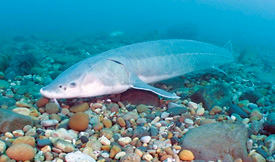The first of nine rock reefs is under construction in the St. Clair River delta northeast of Detroit. The goal of the project, which is led by Michigan Sea Grant, is to boost populations of lake sturgeon and other rare native fish by providing river-bottom rock structures where they can spawn.
The rock reefs are designed to assist several native species that are considered threatened or endangered in Michigan, including lake sturgeon, mooneye, the northern madtom catfish and the river redhorse sucker. Walleye, a popular sport fish, and commercially important lake whitefish also should benefit.

Michigan native fish like this sturgeon will benefit from nine new rock spawning reefs to be built in the St. Clair River delta northeast of Detroit. Photo by Adam Lintz.
The new reefs will be constructed in the Middle Channel of the St. Clair River delta, near an existing lake sturgeon spawning site. The $1.1 million St. Clair project is a follow-up to rock reefs built on the Detroit River in 2004 and 2008.
“We’ve been working together on these reefs for more than 10 years now, and over the course of time we’ve really figured out what kinds of physical characteristics the fish are attracted to,” says project leader Jennifer Read, acting director of Michigan Sea Grant, a cooperative program of U-M and Michigan State University. Michigan Sea Grant is a Center of Excellence at the School of Natural Resources and Environment.
“A long-term goal of this team is to create enough fish-spawning habitat in the river so that we have really robust, self-sustaining populations of lake sturgeon, whitefish and walleye,” Read says.
Each of the nine rock reefs in the Middle Channel will be 120 feet long, 40 feet wide and 2 feet high. They will be 25 to 30 feet below the water’s surface — deep enough to prevent plant growth or interference with boat traffic. Two hundred boulders will be placed downstream of the nine reefs to provide a safe place, out of the current, for fish to gather before spawning.
The reefs are composed of 4-to-8-inch chunks of angular limestone and rounded fieldstone. Crevices between the loosely piled rocks are designed to protect fish eggs from being washed downstream or consumed by predator fish.
Beginning in the early 1900s, the rivers connecting lakes Huron and Erie were straightened, widened and deepened to create shipping channels for large freighters. Dredging and blasting of the channels eliminated many natural fish-spawning sites, contributing to population declines in several species, including lake sturgeon.
Even so, the Huron-Erie connecting channels — the St. Clair River, Lake St. Clair and the Detroit River — continue to provide enough spawning habitat for growth of the largest remaining population of lake sturgeon in the Great Lakes, according to Michigan Sea Grant. Lake sturgeon can grow up to 6 feet in length, weigh up to 100 pounds, and can live more than 100 years.
The new Middle Channel reefs will be built near an existing lake sturgeon spawning reef that was inadvertently created more than a century ago when steam-powered freighters dumped coal cinders into the river.
“The sturgeon are here in great numbers to spawn at that little reef, and the problem is there’s not enough room there for all of them,” says Bruce Manny, a U.S. Geological Survey fishery biologist who has worked on the reef-building projects for more than a decade.
Construction of the nine St. Clair River rock reefs is expected to be completed this month.
Two more large spawning reefs for native fish are being planned for the St. Clair River in 2013 and 2014.

